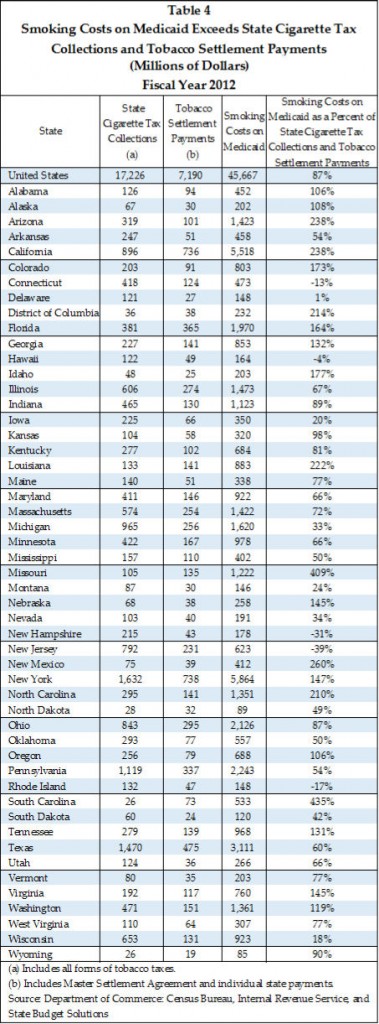How Electronic Cigarettes Could Save Medicaid Billions of Dollars
In the relatively short time they’ve been around, electronic cigarettes have shown great potential for reducing the levels of morbidity and mortality associated with tobacco smoking. Scientific studies have proven time and time again that they can be an efficient alternative to analogs, and, according to a recent analysis, they could save Governments dozens of billions more than what they currently collect through steep tobacco taxes.
 Although e-cigarette opponents would have you think otherwise, current scientific evidence shows vaping is infinitely less damaging to human health than smoking. Since there is no combustion in these electronic devices, there is also no risk of inhaling tar and carbon monoxide, which, research has proven, are the main causes of smoking-related health problems. Nicotine, by itself, though highly addictive, acts only as a stimulant similar to caffeine, and studies show that the traces of toxic substances detected in e-liquid and vapor produced by e-cigarettes are between 9 and 450 times lower than tobacco cigarettes, as well as under the danger threshold.
Although e-cigarette opponents would have you think otherwise, current scientific evidence shows vaping is infinitely less damaging to human health than smoking. Since there is no combustion in these electronic devices, there is also no risk of inhaling tar and carbon monoxide, which, research has proven, are the main causes of smoking-related health problems. Nicotine, by itself, though highly addictive, acts only as a stimulant similar to caffeine, and studies show that the traces of toxic substances detected in e-liquid and vapor produced by e-cigarettes are between 9 and 450 times lower than tobacco cigarettes, as well as under the danger threshold.
There is no questioning the fact that more research is needed to identify the long-term effects of vaping on the human body, but why would you want to take a defensive stance on a product that has yet to be proven dangerous, when you have a known killer to deal with? Official statistics say smoking causes premature death in 50% of smokers, but we have yet to hear about a serious health problem associated with the use of electronic cigarettes. The question becomes even harder to answer when you consider the fact that electronic cigarettes have the potential to render smoking obsolete.
Let’s consider for a moment the idea that Governments care less about public health and more about the billions of dollars collected every year through the ever-growing tobacco taxes they’ve grown so fond of in the last few decades. It’s a disturbing hypothesis, but one that’s been used as an explanation to the states’ aggressive war on e-cigarettes on more than one occasion. Only it turns out they would be saving a lot more money if they embraced electronic cigarettes as an alternative to smoking.
According to an analysis recently posted on StateBudgetSolutions.org, the adoption of electronic cigarettes and resulting smoking cessation and harm reduction could have saved the US up to $48 billion in Medicaid spending, in the fiscal year 2012. That is 87% more than all cigarette taxes and tobacco settlements collected in that same year – $24.4 billion.
According to a report by the Center for Disease Control and Prevention, 21.2% of Americans smoked tobacco cigarettes in 2011. Smoking rates varied across states, with the top three being Kentucky (29%), West Virginia (28.6%), and Arkansas (27%) and the three lowest states being Utah (11.8%), California (13.7%), and New Jersey (16.8%). Furthermore, the rates varied significantly by income level: 28% of people living below the poverty line smoked, compared to 17% of those above the line. Consequently, smoking prevalence among Medicaid recipients is more than twice that of the general public, 51% compared to 21%.
Overall, the US Medicaid system caters to 68 million people, of which 36 million are smokers. Considering the serious health  conditions associated with smoking, there’s no denying the high financial strain it puts on the system, which ultimately leads to the spending of valuable resources desperately needed in other areas of our society.
conditions associated with smoking, there’s no denying the high financial strain it puts on the system, which ultimately leads to the spending of valuable resources desperately needed in other areas of our society.
But the adverse effects of smoking also create negative externalities that further impact the economy. In 2009, a comprehensive
study identified the two main costs of smoking were loss of productivity and increased healthcare costs. Lost productivity occurs when a person dies as a result of smoking or misses time off work due to smoking-related illnesses. Research showed this lost output cost the US economy $185 billion in 2009. Healthcare costs for medical services required by smokers amounted to another $116 million, putting the grand total of smoking-related externalities for 2009 at $301 billion.
In 2009, Brian S. Armour et. at devised an impressive economic model to estimate the cost of smoking on Medicaid, based on data from the Medical Expenditure Panel Survey and the Behavioral Risk Factor Surveillance System. The researchers’ model included 16,201 adults with weighting variables that allowed them to generate state representative estimates of the adult, noninstitutionalized Medicaid population.
The study concluded that 11% of Medicate spending was attributed to smoking, with costs varying by state, from a high of 18% (Arizona and Washington) to a low of 6% (New Jersey). In the fiscal year 2012, smoking cost the Medicaid system 45.7 billion, while the combined cigarette excise taxes and tobacco settlement payments amounted to only $24.4 billion. As seen in Table 4, from a state-by-state perspective, the potential Medicaid savings exceeds cigarette excise tax collections and tobacco settlement payments by 87%.
Lastly, Governments stand to save other hundreds of millions of dollars by reducing smoke and fire dangers in subsidized and public housing. According to a recent study, smoking induces costs amounting to $500 million through fires associated with cigarettes, increased renovation costs of housing units where smoking is permitted and healthcare costs from exposure to second-hand smoke within and between housing units.
While it’s true that the number of smokers in the US has been steadily declining for years, there is still a long way to go, and increasing cigarette taxes, subsidized nicotine replacement therapies and anti-smoking campaigns can only do so much and are a burden to the already strained Medicaid system. Electronic cigarettes could prove to be a win-win solution for both policy makers and taxpayers.
Academic research has already confirmed e-cigarettes’ potential for harm reduction, their rapid adoption by a large percentage of former smokers stands as further proof of their effectiveness to replace cigarettes, but unless Governments decide to give them a chance, electronic cigarettes will not reach their full potential. Heavy regulations from the FDA and extending cigarette taxes to e-cigarettes will only slow down the rate of adoption by smokers and curb innovation without really benefiting public health and the economy in any way.
As with any disruptive technology, there’s bound to be a degree of fear involved, but until we have some hard evidence that electronic cigarettes pose a real danger, we have to look at the facts. Science shows they pose a minimal health risk and have great potential for harm reduction, and a financial analysis proves they could save Governments billions in healthcare costs.
















